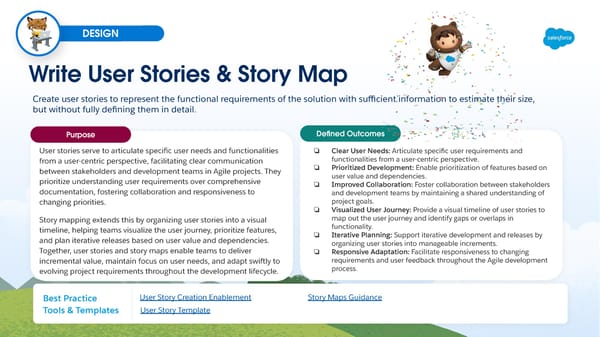DESIGN Write User Stories & Story Map Create user stories to represent the functional requirements of the solution with sufficient information to estimate their size, but without fully defining them in detail. Defined Outcomes Purpose ❏ Clear User Needs: Articulate specific user requirements and User stories serve to articulate specific user needs and functionalities functionalities from a user-centric perspective. from a user-centric perspective, facilitating clear communication ❏ Prioritized Development: Enable prioritization of features based on between stakeholders and development teams in Agile projects. They user value and dependencies. prioritize understanding user requirements over comprehensive ❏ Improved Collaboration: Foster collaboration between stakeholders documentation, fostering collaboration and responsiveness to and development teams by maintaining a shared understanding of project goals. changing priorities. ❏ Visualized User Journey: Provide a visual timeline of user stories to map out the user journey and identify gaps or overlaps in Story mapping extends this by organizing user stories into a visual functionality. timeline, helping teams visualize the user journey, prioritize features, ❏ Iterative Planning: Support iterative development and releases by and plan iterative releases based on user value and dependencies. organizing user stories into manageable increments. Together, user stories and story maps enable teams to deliver ❏ Responsive Adaptation: Facilitate responsiveness to changing Salesforce Adoption Dashboards requirements and user feedback throughout the Agile development incremental value, maintain focus on user needs, and adapt swiftly to process. evolving project requirements throughout the development lifecycle. User Story Creation Enablement Story Maps Guidance Best Practice User Story Template Tools & Templates
 A Partner Readiness Guide to Deliver Like Salesforce Page 66 Page 68
A Partner Readiness Guide to Deliver Like Salesforce Page 66 Page 68